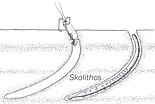Aganane Formation
[3][4][5] It may also include the fossiliferous levels of the Calcaires du Bou Dahar, if true, it would be one of the richest Early Jurassic formations in the entire tethys area.
[8] The nearshore sections, including both carbonate platforms and close to sea terrestrial facies where located on an isolated internal domain thanks to the control of the barrier, allowing the Aganane Formation to develop on a hot and humid climate, where a local algal marsh had intermittent progradations, intercalated with a layer of terrigenous continental origin.
[12] These sediments suggest a continental zone bordering river courses, connected to coastal sectors where shales and siltstones derived from Sabkhas in which interstitial evaporites were formed.
[14] In the intertidal zone, pelletoid lime packstones and wackestones, often bioturbated, reflect shallow, low-energy conditions, with variable amounts of terrigenous material.
Oolitic lime grainstones, well-sorted and cross-bedded, indicate high-energy conditions likely associated with tidal distributary bars, while crinoid and mollusc packstones suggest quieter waters around shoals.
[12] Algal laminated boundstones developed in both supratidal and intertidal zones, following present-day patterns such as Shark Bay in Australia or the Persian Gulf.
[13][10] Additionally, more massive facies with large Plicatostylidae separated the tidal flat from the open sea with Ammonites, whose western extension bordered the eastern edge of Azilal.
Subtidal deposits include both those of an intertidal nature, indicating shallow water or coastal lagoons, with extensive accumulations of skeletal lime packstones, oolitic tidal deltas and offshore bars, oncoliths and coral reefs, and occasional bivalves Opisoma spp., while further east the more open subtidal conditions are represented by flint-bearing calcareous shales and sparse faunas where ammonites begin to appear.
[15][16][17] Locally, these reefs were developed as shallow subtidal, cross-bedded floatstones, later evolving to layers with evidence of subaerial exposure, including lagoonal marls, and bioturbated red mudstones with root traces and calcrete.
[19] The environment spans from supratidal flats to subtidal zones, with eastern laminated shales transitioning to marine grainstones, indicating a regressive phase with barrier island formation separating intertidal deposits from deeper biodetritic slope deposits, all latter covered with laminated shales with coal streaks and abundant plant fragments, recording an anoxic coastal lagoon.
[12] The scarcity of terrigenous material and the prevalence of wind-transported red mud and fine sand further indicate low precipitation, with strong winds (common in modern regions like the Persian Gulf and Shark Bay) serving as a key sediment transport mechanism.
Periodic storms, similar to Shark Bay’s winter gales, significantly shaped sedimentation, leaving behind erosional and depositional structures consistent with arid environments.
However, Ophiomorpha burrows near Ait Ourir suggest occasional normal marine salinities in the trough’s center during maximum transgression (seen in the older Imi-n-Ifri Formation).
This environment represents a shallow, coastal area similar to modern tidal flats where seawater periodically covered the land during high tides.
Areas like Ait Athmane or Tizi n'Terghist record rhizoliths (including massively rooted levels), tree trunks, red clay with paleosols and pisoids, which are indicative of pedogenic or freshwater vadose conditions with periodic exposure to air and fresh water.
[16][23][24] In other localities are mainly biodetritic limestones, showing emersion structures at their top (dolomitization, mud cracks, roots and plant remains, footprints of Dinosaurs).
[17][21][25] Red and white marls mixed with thin dolomite layers suggest periods of exposure to the air, with sediments deposited by rivers and occasional flooding from the sea.
This part of the formation often shows signs of marine life, including llamellibranchs, gastropods, brachiopods, with calcareous algae (Palaeodasycladus, Solenopora, etc.)
[25][26] Subtidal influences are observed in oncolitic lime wackestones, indicating a relatively low-energy environment with occasional mixing from higher-energy conditions.
The transition between these reef zones and the inner platform was gradual, with occasional storm events depositing coarse sediments into the quieter lagoon areas.
[25] Small cycles within the bank with frequent reworking and/or rearrangement phenomena demonstrate the importance of episodic storms, which repeatedly led to the displacement of individual facies zones.
[4] During the Pliensbachian, the region was situated at a nearly tropical paleolatitude and marked the western boundary of the ancient "Atlas Gulf," which faced the Tethys Sea to the East.
[10] This fault line probably marked the northern boundary of a Paleozoic basement peninsula that advanced eastward from the Tichka Massif into the Atlas Trench.
[24] The paleogeographic evolution of our region can be described in three main stages: Local Foraminifers have been the major reference to stablish the local different enviromental settings, as it´s distribution is clearly based on cyclic sedimentary evolution: the base banks "Term A" represents a shallow subtidal setting with rich thanatocoenosis of Siphovalvulina, Mayncina or Orbitopsella, associated with a intensely bioturbated environment, analogous to present Bahamas, Florida or Persian Gulf.
[25] In the Aganane type section limestone beds (biopelmicrite) rich in Orbilopsella, Haurania or Pseudopfenderina could be interpreted as brought by tidal currents covering the supratidal zone.
[28] During D, the foraminiferal population was dominated by Planisepta, a smaller morphovariant of Lituosepta, which persisted after the decline of larger orbitopsellids like Orbitopsella due to internal biological factors and mechanical instability related to their large size.
Dominant Plicatostylidae bivalves, in a way akin to modern Crassostrea, thrived in both clear and turbid waters, forming biostromes and bioherms in protected lagoons.
Co-existing scleractinian corals, possibly photosymbiotic, suggest warm, clear, oligotrophic conditions, yet their symbiotic nature is hard to confirm in fossils.
Abundant along the rootlets, indicating a very shallow and restricted lagoon or swamp environment Liogryphaea[23][15][20] Isolated Shells A saltwater bivalve of the family Gryphaeidae.
This genus was founded to be a bivalve with a juvenile byssate stage that developed different lifestyles in adulthood depending on the density of individuals and the firmness of the bottom.
















































